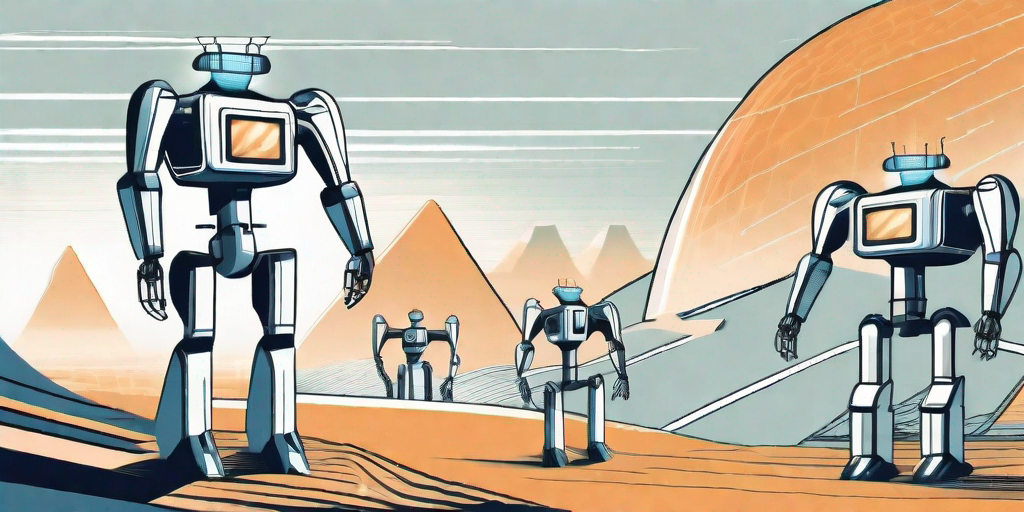Innovation Futurist's Role in Explaining Robotics Understanding

Innovation Futurist's Role in Explaining Robotics Understanding
In today's fast-paced world, innovation futurists play a crucial role in bridging the gap between cutting-edge technology and our understanding of it. One area where their expertise is particularly valuable is robotics. As the field of robotics continues to evolve and transform various industries, it is essential to have individuals who can decipher complex concepts and communicate them effectively to others. In this article, we will explore the role of an innovation futurist in explaining robotics understanding and how their insights can shape the future of this exciting field.
Understanding the Basics of Robotics
Before delving into the role of an innovation futurist, it is important to have a grasp of the basics of robotics. At its core, robotics involves the design, creation, and operation of robots to perform tasks autonomously or with minimal human intervention. From industrial robots streamlining manufacturing processes to drones revolutionizing the delivery industry, robots have become an integral part of our lives.
Robots are designed to perform specific functions, and their capabilities vary depending on their intended purpose. They can be equipped with sensors, actuators, and artificial intelligence algorithms that enable them to perceive their environment, make decisions, and carry out actions accordingly. Understanding these fundamental principles lays the foundation for comprehending the advancements and potential of robotics.
One fascinating aspect of robotics is the wide range of industries that benefit from its applications. In the medical field, robotic surgical systems have revolutionized the way complex surgeries are performed. These systems provide surgeons with enhanced precision, flexibility, and control, resulting in improved patient outcomes. Additionally, robots are being used in rehabilitation centers to assist patients in regaining their mobility and independence.
In the agricultural sector, robots are being employed to automate various tasks, such as planting, harvesting, and monitoring crops. These robots can navigate through fields, identify and remove weeds, and even collect data on soil conditions and crop health. By reducing the need for manual labor and optimizing farming practices, robots contribute to increased efficiency and sustainability in agriculture.
Furthermore, the automotive industry heavily relies on robotics for manufacturing processes. Industrial robots are utilized in assembly lines to perform repetitive tasks with speed and precision. These robots can handle heavy materials, weld components, and apply paint, ensuring consistent quality and reducing production time. The integration of robotics in automotive manufacturing has significantly improved productivity and product reliability.
Robots are also making significant advancements in the field of exploration and space research. Space agencies utilize robots to conduct missions in environments that are too dangerous or inaccessible for humans. For example, rovers like NASA's Curiosity have been deployed on Mars to explore the planet's surface, collect samples, and gather valuable data about its geology and potential for supporting life.
As technology continues to evolve, the potential of robotics expands even further. The development of soft robotics, which involves creating robots with flexible and adaptable structures, opens up new possibilities for applications in areas such as healthcare, disaster response, and search and rescue operations. These robots can navigate complex environments, interact safely with humans, and perform delicate tasks with precision.
In conclusion, the basics of robotics encompass the design, creation, and operation of robots to perform tasks autonomously or with minimal human intervention. Understanding the fundamental principles of robotics allows us to appreciate the diverse applications and potential of this field. From healthcare and agriculture to automotive manufacturing and space exploration, robots continue to transform industries and push the boundaries of what is possible.
The Role of an Innovation Futurist in Advancing Robotics
Now that we have a basic understanding of robotics, let's explore the crucial role of an innovation futurist in advancing this field. Innovation futurists are experts who possess a deep understanding of emerging technologies and their potential impact on society. They have their finger on the pulse of innovation, constantly monitoring the latest trends and breakthroughs.
One of their primary tasks is to analyze complex technological concepts and translate them into easily digestible information for the general public. This is particularly important when it comes to robotics. As robots become more integrated into our daily lives, it is crucial that people understand their capabilities, limitations, and ethical implications.
An innovation futurist acts as a translator, breaking down intricate technical jargon into relatable terms and real-world examples. They bridge the gap between the experts developing robotic technologies and the wider audience who may not have specialized knowledge in this field. By doing so, they empower individuals and organizations to make informed decisions and embrace the potential of robots.
Furthermore, innovation futurists play a vital role in shaping the future of robotics by identifying and predicting emerging trends. They closely monitor advancements in artificial intelligence, machine learning, and sensor technologies, among others, to anticipate the next big breakthrough in robotics. By staying ahead of the curve, they can guide researchers, engineers, and policymakers in making strategic decisions that will drive the field forward.
Innovation futurists also serve as advocates for responsible and ethical development and deployment of robots. They raise awareness about potential risks and challenges associated with robotics, such as job displacement and privacy concerns. By engaging in public discourse and collaborating with stakeholders, they help shape policies and regulations that ensure the safe and beneficial integration of robots into society.
Moreover, innovation futurists actively participate in research and development projects, working alongside engineers and scientists to explore new possibilities and push the boundaries of what robots can do. They contribute their expertise in understanding societal needs and preferences, helping to design robots that are not only technologically advanced but also socially acceptable and user-friendly.
As the field of robotics continues to evolve, innovation futurists will play an increasingly important role in driving its progress. Their unique blend of technical knowledge, strategic thinking, and communication skills make them invaluable in advancing robotics and shaping a future where robots are seamlessly integrated into our lives.
Future Trends in Robotic Technology
As innovation futurists guide us in understanding the present, they also help us envision the future of robotic technology. The field of robotics is constantly evolving, with new advancements fueling its growth. By closely monitoring the trends and developments within the industry, innovation futurists can provide valuable insights into what the future holds.
Robots are expected to become even more versatile, capable, and integrated into our lives. From healthcare and agriculture to transportation and space exploration, there is virtually no industry that will remain untouched by the transformative power of robotics.
For example, in the healthcare sector, robots are already aiding in surgeries, rehabilitation, and patient care. Innovation futurists can help us imagine a future where robots revolutionize healthcare delivery, providing personalized and efficient treatment options for patients worldwide.
Imagine a world where robotic surgeons work alongside human doctors, performing complex surgeries with precision and accuracy. These advanced robots would have the ability to analyze patient data, make real-time decisions, and execute surgical procedures with minimal invasiveness, resulting in faster recovery times and improved patient outcomes.
Furthermore, innovation futurists can envision a future where robots play a crucial role in eldercare. With an aging population, the demand for healthcare services is increasing, and robots can fill the gap by providing companionship, assistance with daily activities, and monitoring vital signs. These robotic companions would not only alleviate the burden on healthcare providers but also enhance the quality of life for the elderly.
Similarly, in the realm of transportation, advancements in autonomous vehicles and drones hold immense potential for enhanced safety, efficiency, and sustainability. Innovation futurists can shed light on how these technologies will reshape the way we commute and transport goods.
Imagine a future where self-driving cars dominate the roads, significantly reducing traffic congestion and accidents. These autonomous vehicles would communicate with each other and the surrounding infrastructure, optimizing traffic flow and minimizing travel time. Additionally, with the integration of renewable energy sources, such as solar panels, these vehicles would contribute to a greener and more sustainable transportation system.
Moreover, innovation futurists can explore the possibilities of drone delivery services. Imagine a world where drones seamlessly transport packages and goods, bypassing traffic and delivering items directly to our doorsteps. This would not only revolutionize the e-commerce industry but also reduce carbon emissions associated with traditional delivery methods.
In conclusion, the future of robotic technology is brimming with exciting possibilities. With the guidance of innovation futurists, we can anticipate a world where robots play a vital role in healthcare, transportation, and various other industries. These advancements have the potential to improve efficiency, safety, and quality of life for individuals worldwide. As we embrace the transformative power of robotics, we embark on a journey towards a future filled with endless opportunities.
How Innovation Futurists Can Help in Exploring Robotics Potential
Innovation futurists not only explain the current state and future trends of robotics but also help explore its vast potential. By facilitating discussions, workshops, and collaborations, they bring together multidisciplinary experts to envision new applications and unlock untapped opportunities.
For instance, innovation futurists can organize hackathons where engineers, designers, and entrepreneurs collaborate to develop innovative robotics solutions. These events not only foster creativity but also encourage cross-pollination of ideas, leading to groundbreaking breakthroughs in the field.
Furthermore, innovation futurists can identify key challenges and bottlenecks that need to be addressed for robotics to reach its full potential. They actively engage with policymakers, industry leaders, and researchers to advocate for supportive policies, ethical guidelines, and investment in research and development.
Implementing Robotics Based on Futurist Insights
One of the most tangible outcomes of an innovation futurist's role in explaining robotics understanding is the practical implementation of these insights. Armed with the knowledge and foresight provided by innovation futurists, organizations can make informed decisions about integrating robotics into their operations.
By understanding the capabilities of robotics and the potential benefits they offer, businesses can identify areas where robots can streamline processes, enhance productivity, and improve safety. Whether it's automating repetitive tasks in manufacturing or using autonomous drones for inspection purposes, innovation futurists can guide organizations in embracing these technologies strategically.
Moreover, innovation futurists can assist in addressing societal concerns and ethical considerations surrounding robotics. They can advocate for responsible and inclusive implementation, ensuring that the benefits of robotics are distributed equitably across society.
Conclusion
Innovation futurists play a pivotal role in explaining robotics understanding and shaping the future of this exciting field. By translating complex concepts into relatable terms, they empower individuals and organizations to embrace the potential of robotics. Through their insights, innovation futurists guide us in understanding the present, envisioning future trends, exploring untapped opportunities, and implementing robotics strategically. As robots continue to advance and redefine industries, having innovation futurists by our side is essential to navigate this ever-evolving world.
FAQ
1. What is the role of an innovation futurist in explaining robotics understanding?
An innovation futurist acts as a translator, breaking down intricate technical jargon into relatable terms and real-world examples. They bridge the gap between the experts developing robotic technologies and the wider audience who may not have specialized knowledge in this field.
2. How do innovation futurists shape the future of robotics?
Innovation futurists closely monitor advancements in artificial intelligence, machine learning, and sensor technologies to anticipate the next big breakthrough in robotics. They also advocate for responsible and ethical development and deployment of robots, shaping policies and regulations that ensure the safe and beneficial integration of robots into society.
3. What are some future trends in robotic technology?
In the future, robots are expected to become even more versatile, capable, and integrated into various industries. Innovation futurists envision a future where robots revolutionize healthcare delivery, work alongside human doctors in surgeries, and play a crucial role in eldercare. They also anticipate advancements in autonomous vehicles and drones, transforming transportation systems and delivery services.
Contact an Innovation Futurist for Your Event
Are you looking to bring a dynamic and insightful speaker to your next event? Look no further than Dr. Mark van Rijmenam, an innovation futurist who can provide invaluable expertise on the future of robotics and its impact on various industries. With his deep understanding of emerging technologies and their potential, Dr. van Rijmenam is the perfect choice to engage and inspire your audience.
By hiring Dr. Mark van Rijmenam, you can ensure that your event is filled with thought-provoking insights and actionable takeaways. His ability to translate complex concepts into relatable terms will captivate your audience and leave them with a deep understanding of the potential of robotics. Whether you are organizing a conference, workshop, or corporate event, Dr. van Rijmenam will deliver a compelling and engaging presentation that will leave a lasting impact.
To book Dr. Mark van Rijmenam for your next event, simply complete the form below, and we will be in touch within 24 hours. Don't miss out on the opportunity to have a renowned innovation futurist share his expertise and shape the future of your event.





